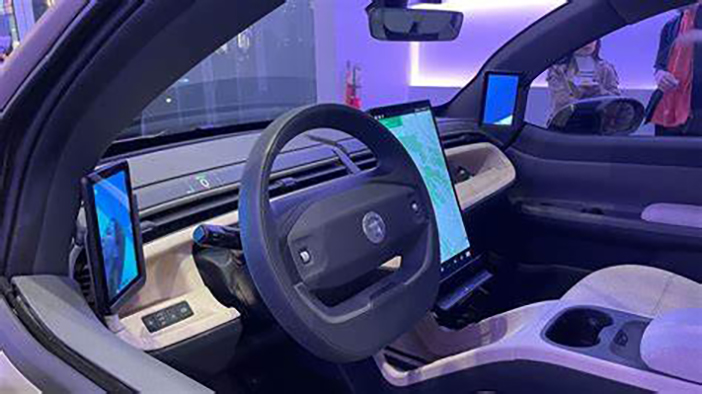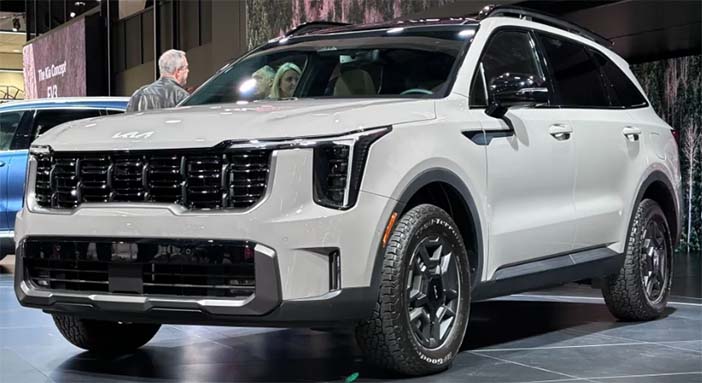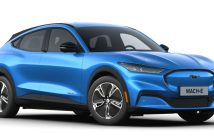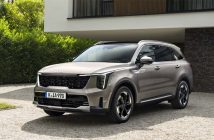+++ The sleek AUDI E-TRON GT is being readied for a mid-life update, giving the high-end electric vehicle (EV) a boost of appeal as part of what will be a very busy 2024 for Audi. Based closely on the Porsche Taycan, which will also receive a mid-life update next year, I suspect the new e-Tron GT will include some key tech upgrades around the powertrain and batteries, as well as a new look on the outside. Both Audi (and Porsche) are being tight-lipped about potential updates to the powertrain, but given the speed of battery and EV powertrain development I’d expect the e-Tron GT to feature some improvements to both range and performance, building on its impressive 800 Volt electronic architecture. The current e-Tron GT features a 93.4 kWh battery pack with the base and RS models producing either 476 hp and 598 hp from their twin-motor setups. Porsche has been spied putting together what could be a new range-topping triple-motor variant, but whether Audi will be preparing a similar super-high performance model is still yet to be determined. The updated E-Tron GT will feature a new front bumper, with larger air intakes on either side of the now solid single-frame grille. We can also expect a much more open wheel design, with large carbon ceramic brakes fitted behind on the high-spec RS version. At the back, the e-Tron GT gets a new rear bumper. I expect there to be some specification and material changes inside the cabin, even though it is still unknown whether Audi will decide to upsize the relatively small infotainment screen of the current car. We’ll learn more about the next generation E-Tron GT early next year, leading up to a very busy 2024 for the German brand with the new Q6 e-Tron being finalized for production alongside its A6 e-Tron sibling that will follow soon after. +++
+++ Just as the commercial fortunes of EVs has started to improve, a dark cloud has emerged in the shape of increasing ELECTRIC CAR INSURANCE COSTS . The cost of insurance for all car types has increased over the past 12 months, due to factors including used car and spare parts price inflation, labor shortages, extended vehicle loan times, the rising numbers of personal injury claims and insurers’ falling investment returns. What’s more, premiums for petrol and diesel cars have only risen by 29% within the same period, so what exactly is going on? According to the British comparison provider Confused.com, the average premium across all car types has increased by 58% in the past 12 months. However, this masks higher premium increases for EVs, which in the same period shot up 72%, compared with 29% for petrol and diesel cars. In a report published earlier this year, Thatcham Research, a British specialist in automotive risk intelligence funded by insurers, highlighted the challenges that insurers face in covering EVs and the factors influencing the vehicles’ higher premiums. They include higher incident claims costs than for ICE cars, longer repair times and the expensive requirement for the safe storage of damaged EVs. Figures from the Association of British Insurers show that claims for EVs are 25.5% more expensive than for their petrol- and diesel engined equivalents and that their repair times are 14% longer. Thatcham’s report also raised the consequences of collisions for the viability of an EV, noting that “there is a concerning lack of affordable or available battery-repair and post-accident diagnostic solutions, leading to EVs being written off prematurely and causing claims costs to rise disproportionately”. On this point, a major problem for insurers is the high cost of a replacement battery relative to the declining value of the EV to which it would be fitted. Often, the price of a replacement battery is higher than the market value of the average EV after only 1 year. This is turning the insurance model on its head, according to Thatcham engineering manager Mark Fry. “Where in the past the balance of risk has been on the driver, as this new EV technology comes in, we’re starting to see the risk shift towards the car”, he said. “To address it, we’re working with car makers to ensure they’re designing their EVs with ease of repairability in mind and that they have repair methods and good parts availability in place so that the vehicles can be sustainably repaired and returned to the road quickly”. Tim Kelly, founder of Motor Claim Guru, agreed that high repair and parts replacement costs are a contributor to EVs’ higher insurance costs but argued that ultimately most of the blame should go on the high prices of the EVs themselves. “The highest risk to an insurer is the market value of a car, while only around 6% of an insurance premium is the cost of repairing it”, he said. “As the transition to electric gathers pace and the volume of third-party claims involving EVs increases, so will insurers’ exposure to this risk”. Despite insurers’ fears about the increasing numbers of EVs on our roads, Kelly predicts this will actually help drive down the cost of insuring such cars. “As more second-hand EVs enter the market at lower prices, so their insurance premiums will fall”, he said. Fry claimed that increased EV numbers will also give repairers the confidence to invest in EV repairs. “As we see more EVs in the market, so I expect to see more repairers invest in the equipment and skilled staff required to repair them”, he said, meaning the present challenges will start to be ironed out. +++
+++ FISKER put a Pear on display at the L.A. Auto show in production spec. The latest display came with a few more updates on the urban EV planned to enter production at the end of next year at Foxconn’s plant in Lordstown, Ohio. The first new bit is what’s being called a “see-through A-pillar”. The only car I’ve ever seen with an actual see-through A-pillar was the 2001 Volvo Safety Car Concept, the feature not making it to production on the C30 hatchback, regrettably. On the Pear, the see-through bit is performed by cameras projecting the view obscured by the A-pillars onto small screens located inside the cabin where the instrument panel meets the doors. These screens would also help explain Fisker’s desire to sell the Pear with side-view cameras in the U.S., since the screens are already there. The displays weren’t shown in the photos Fisker released in August, but they were in the auto show car. The automaker again noted there will be two battery options, the smaller with an urban-centric estimated range of 290 km, the larger Hyper Range pack aiming at an estimated 500 km. The press release says the little crossover targets “a base 0-100 kph time of 6.5 seconds”. I don’t know if “base” in this case means the quickest time among the 2 trims, 2 drivetrains (RWD and AWD), and 20-inch wheels on all-season tires or 22-inch wheels on high-performance tires, or if it refers to the base model’s smaller battery pack. Either way, seems there’s a quicker option coming, Fisker mentioning a high-performance trim called the Pear Extreme. I was treated to some tech specs on the Blade computer that’s the brains of the Pear, but I’m still waiting to find out what the promised processing and wireless data speeds will mean for the user experience. When introducing the Alaska pickup and the Pear to the audience, Henrik Fisker seems to have described the Blade as being 2 computers and called it “the latest, newest standard of the world”. One aspect not mentioned in the PR is what looks like a projected gauge cluster. The Pear in the photos from August fitted a slightly different instrument panel than the car at the show. At 1:22 in a walkaround video Fiskerati shot at the L.A. show, the Pear’s dashboard appears to show vehicle information projected onto the instrument panel behind the steering wheel. I can make out a zero and what I’d guess is a word above it, perhaps the word “Speed”. There are 2 more illuminated bits of information on either side of the zero, but I can’t make those out at all — maybe it’s a gear indicator on the right? Henrik continues to project deliveries starting in early 2025 at a starting price of €40.000 in the Netherlands. Fingers crossed. +++

+++ FORD is resuming construction on a Michigan electric vehicle battery plant that the company postponed 2 months ago during a strike by the United Auto Workers union. But the automaker says that due to slowing electric vehicle sales growth, it will scale back the factory size, cutting the number of planned jobs by about one third from 2.500 to 1.700. The annual battery cell output will drop from enough for 400.000 vehicles per year to about 230.000. Ford put the plant, originally to cost $3.5 billion, on hold in late September as the union went on strike at targeted assembly plants run by Ford, General Motors and Stellantis. The contract dispute ended last week with workers at all three voting to ratify new agreements. Spokesman Mark Truby said Tuesday that the company looked at growth forecasts for electric vehicle sales, its EV product plans and whether it could make a sustainable business out of the factory in Marshall, about 160 km west of Detroit. “We are now good to confirm that we are moving forward with the plant”, he told reporters. The plant will open in 2026 on the same timeline as the company set when it announced the factory in February. It will produce batteries with a lithium-iron-phosphate (LFP) chemistry, which is cheaper than the current nickel-cobalt-manganese chemistry now used in many EV batteries. Consumers will be able to choose between a battery with lower range and cost, or pay more for higher range and power. Unlike the company’s other battery plants that are joint ventures, the Marshall factory will be a fully owned Ford subsidiary staffed by Ford workers. But China’s CATL, which is known for its lithium-iron-phosphate expertise, would supply technology, some equipment and workers. Truby said he wasn’t sure how much the company would spend on the scaled back plant. U.S. electric vehicle sales are still growing at a high rate, but not as fast as they were last year, causing many automakers to slow their battery and assembly plant building plans. In June of last year, for instance, electric vehicle sales were growing about 90% year over year. But by June of this year, the growth rate had slowed to about 50%, and automakers are fearful it will slow even further with consumers having reservations about how far they can travel and whether charging stations will be available. Stacey LaRouche, press secretary for governor Gretchen Whitmer, said the announcement means that 1.700 new jobs and billions worth of investments are coming to the state to help the economy grow. “While other states have seen projects put on hold, Michigan will be home to Ford’s first battery plant of this kind”, she said. Otie McKinley, a spokesperson for the Michigan Economic Development Corporation, which handles the state’s incentive fund for economic developments, said state incentives for the Ford plant will be reduced from the original numbers based on the final scope of the project. The state has allocated nearly $1.7 billion in incentives for the project, and added $65 million in October for site readiness. When it announced third-quarter earnings in October, Ford said a slowdown in electric vehicle sales and prices has led to a delay in plans to build one of two new joint-venture EV battery factories in Kentucky that was announced 2 years ago. The company also is trimming Mustang Mach-E production and delaying other spending on EVs totaling $12 billion, chief financial officer John Lawler said. Truby said scaling back the Michigan plant was part of the $12 billion. He said the company is still bullish on EVs. “While there is growth both in the U.S. and worldwide, clearly the growth isn’t at the rate that we and others had expected”, he said. +++
+++ Just a few days ago, KIA teased an updated Sorento debut at the 2023 Los Angeles Auto Show. Well, here it is. Kia’s smaller 3-row (smaller than the Telluride, anyway) was completely redesigned for the 2021 model year, so there’s nothing dramatic to report here, but there are a few quality-of-life updates that should interest buyers who plan to keep this family hauler long-term. Unlike some of the items on display at this year’s L.A. show, the 2024 modelyear Kia Sorento isn’t just a retread of something we’ve seen elsewhere. Kia seems intent on keeping its 3-row SUV current and this update comprises more than just a few inexpensive exterior revisions and shifts in packaging. In fact, the visible changes are quite striking for an intermediate update. While the basic proportions and shape of the greenhouse remain unchanged, the Sorento has gone through extensive rhinoplasty. The wide front grille and headlight arrangement on the current model is tossed entirely. Replacing it is a (somehow larger), more upright grille and vertical headlights. Combined with the already high beltline and rear “shoulders”, the new front end makes the facelifted Sorento appear much taller and more upright. Whether that’s an improvement or not? Well, I leave that up to you. The interior overhaul is similarly extensive. Kia moved the infotainment controls to the center stack, freeing up space to expand the screen itself into the space previously occupied by the knobs and bezel. The central vents have changed orientation, no longer matching the tall side vents on the dash and freeing up space for the relocated infotainment buttons and cleaning up what was a busy, somewhat overwrought look to the stack. Kia calls its new screen setup a “panoramic” layout. It now comprises 2 screens (both 12.3-inch; previously, the infotainment was just 10.25 inches) on loaded models, while lower trims get a 4.3-inch TFT for the cluster instead. Highlighting the interior feature updates is the new infotainment unit itself, lifted from the EV9. That means that starting in 2024, wireless Android Auto and Apple CarPlay are available on every Kia Sorento. Previously, only the models without the fancy, navigation-equipped touchscreen offered wireless smartphone integration; the higher trims required you to plug your phone in. No more, says Kia. The hybrid and plug-in models are in the process of being updated and will be introduced as 2025 modelyear cars with the same visual upgrades seen here. Expect details of those closer to their release next year. +++

+++ The TESLA Cybertruck, which is arguably one of the most hyped-up vehicles in recent history, won’t do too much good for the Elon Musk-led EV manufacturer, at least in the short term, and cancelling it would actually be good for the company’s shares. That’s what Jefferies analyst Phillipe Houchois said after cutting the price target to $210 per share on Tesla stock citing reduced earnings and free cash flow estimates. It’s a bold statement, seeing how the Cybertruck is about a week away from finally being delivered. But while the statement about canceling Tesla’s first-ever electric pickup is a stretch, to say the least, the financial analyst’s other remarks aren’t so far-fetched. “Tesla looks stuck in a slow lane for another 12-18 months, unable to capitalize on peer delays while European legacy OEMs launch €25,000 EVs next year and Chinese carmakers set a new pace of shorter product cycles”, Houchouis wrote in a note. This goes hand in hand with what Musk said during the third-quarter earnings call last month. “I just want to temper expectations for the Cybertruck”, Tesla’s CEO said. “It’s a great product, but financially, it will take a year to 18 months before it is a significant, positive cash flow contributor. I wish there was some way to be different but that’s just my best guess”. Houchois added that instead of spending significant resources on the Cybertruck production ramp, the company should instead focus on “high volume global segments and supply of 4680 batteries for the Model Y”. With the much-awaited delivery event on 30 November inching closer, the Cybertruck is finally becoming a reality, 4 years after its unveiling. But not for actual customers, at least not for now, it seems. Tesla might only deliver 10 Cybertrucks at the end of the month and all of them are probably going into the hands of employees, just like the Model 3 was first delivered to 30 company employees back in 2017. That’s not to say the slow initial rollout hindered the Model 3’s global success in any way, seeing how it’s Tesla’s second-best-selling car, behind the Model Y. +++
+++ Professionally and personally I tend to mostly like, sometimes love, and occasionally loathe the things that car companies say and do. But with VOLVO it’s a genuine case of all 3. First, the bits I like most: I’ve driven combustion-engined Volvos on frozen lakes in Sweden, the forests of Finland and some of the hottest and coldest tracks and trails in Canada and the USA; all with 100 percent reliability (apart from a rear light failure) and satisfaction. Back home, I’ve bought and run old-school, tank-like second-hand Volvos for decades. The 240 GLT that I purchased 30-odd years ago was perfect because it’s a usable, practical classic that’s never let me down. Another favorite was the 850 estate, which at the time was the safest wagon. Friends and relatives with demanding jobs and schedules have chosen second-hand Volvos as workhorses, too. Among them is a friend who had an S60 before moving on to 2 V60s. Then there’s my continent-hopping musician/photographer friend, who picked up a 2010 modelyear V50 for a steal. It serves him well on commutes between England and deepest France. Our Volvos have rarely, if ever, suffered breakdowns or other problems. What’s not to like about the above safe, ultra-reliable motors, bought for a song after their original owners took the big depreciation hits? And, what’s not to love about the imminent, pure-electric EX30, with its starting price of €36.795 in the Netherlands? That’s a basic Volvo EV for Opel Corsa GS Electric money. Madness. That’s all the good, positive stuff. But as regular readers will know, I had a major issue with a Volvo test car that was supposed to be delivered to me last month, but never made it. “Dead as a dodo” was how Volvo’s brand ambassador described it to me, and I promised I’d let you know what happened. It took a while to find out, but this XC90 plug-in hybrid suffered “a poor connection within the high-voltage system”. “This is very unusual”, Volvo told me. “With the assistance of our global technical support team, we were able to get to the root of the issue and restore the connection. Now that it’s been rectified, the vehicle is performing normally again.” Whatever normal is: I never did find out. The inference is that something shook loose, but you’d hope that a high-voltage connection would be as safe as houses, wouldn’t you? It’s amazing how easy reputations are to lose, and Volvo has one that was enviable, as the maker of the safest cars on the planet. It’s hard work keeping those reputations intact, especially with new brands snapping hard at your heels. Cars go wrong; they always have and always will, although that should be a lot less likely these days. Technology has many benefits, but whatever the plus point of a “high-voltage system” is, if it’s likely to go wrong, I for one would rather do without. +++



